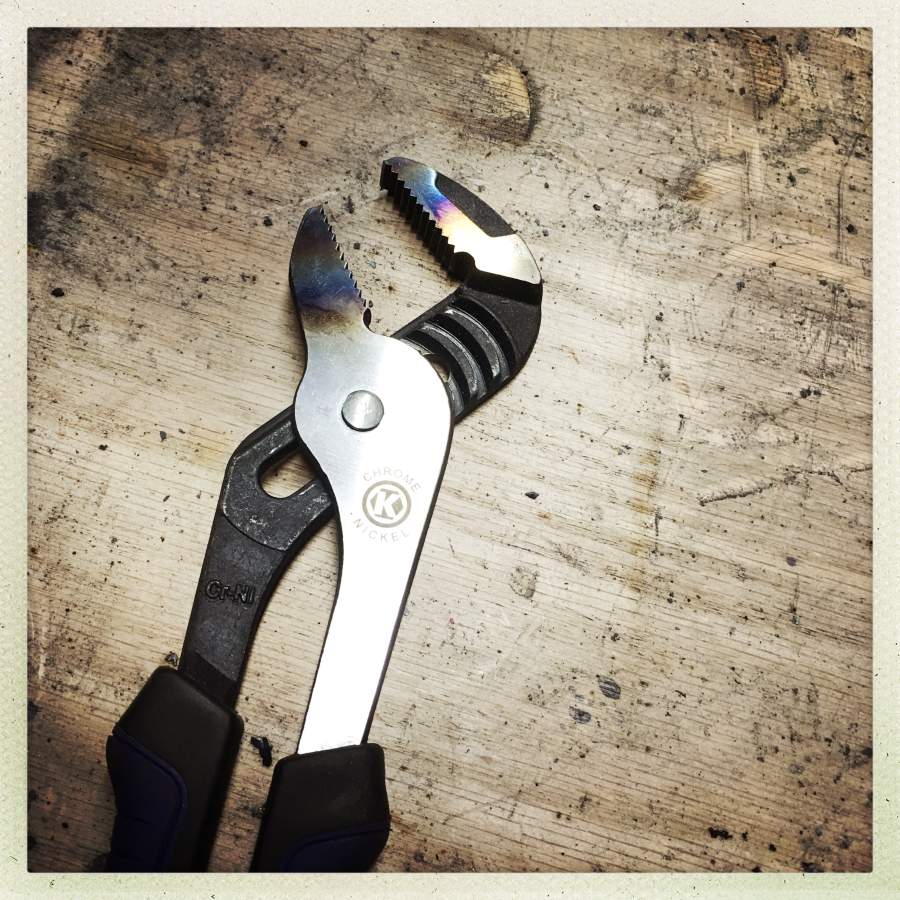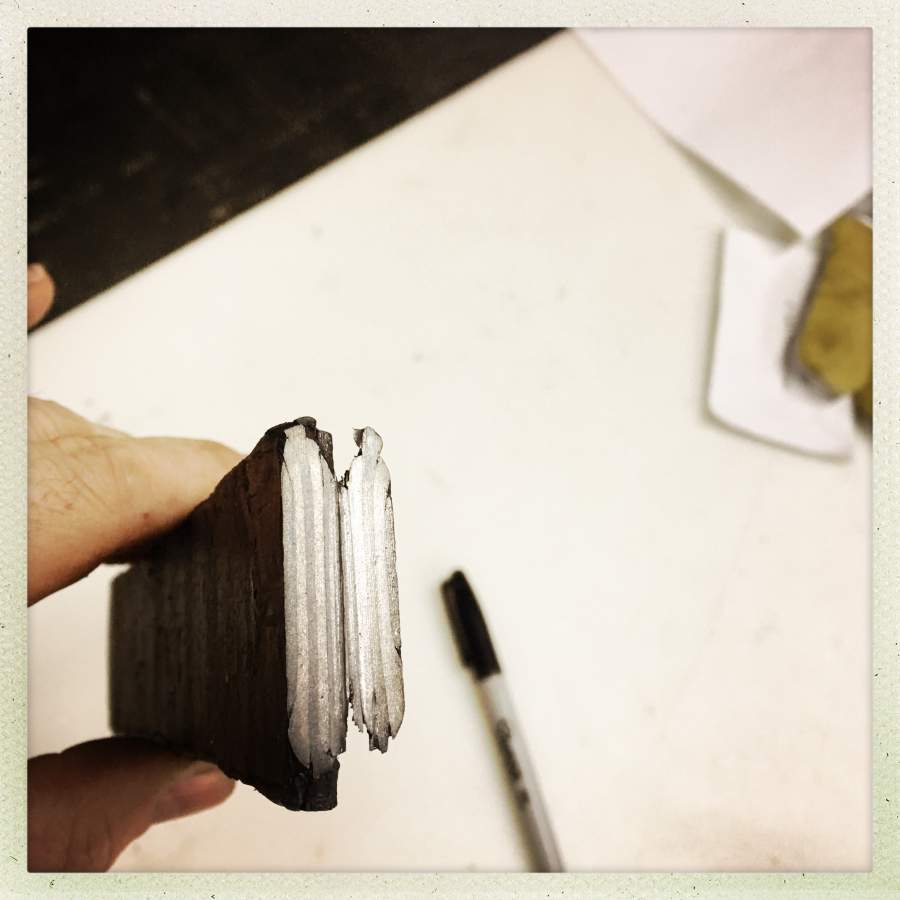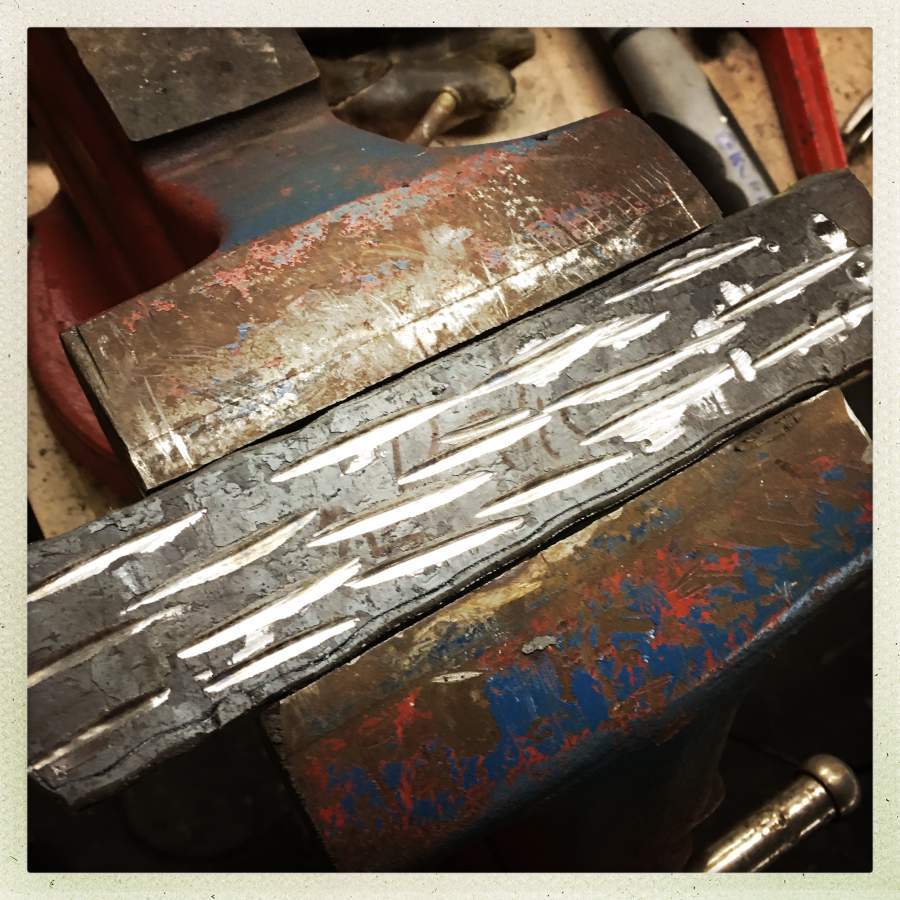I’ve been very busy doing stuff that has to do with the forge, but none of which is forging.
It became time to take a couple steps back and think about infrastructure. Is my safety gear where I need it to be? (No) Stuff like that. One of the nice things about having a workspace that is huge and is not your kitchen is that you can just put your tools down and take a week off.
There’s still a bunch of electrical work that needs doing (the benches need to be wired; I plan to put a long metal shop power-bar under each bench so I can drill through the top and just plug machines in under the deck. There are a lot of screw-ups that involve cutting your own power cables.
But, progress continues:

That’s an ugly blade; I did everything to it. But it’s a marker because it’s the first blade I’ve done bottom-to-top: I stacked the steel and forge-welded it, twisted the bar, drew it out, hammered it flat, shaped the blade, then ground it, quenched it, tempered it, and ground, polished, and etched it. All of those processes worked, which is why I’m happy about it. One reason it’s ugly is because I both pulled a temper line out of it by differential quenching, and made it out of different steels. So, it’s ugly but it’s an experiment and all the steps worked.
So, that means I can think about starting to do serious stuff. Which, I started to do and that made me realize that I need to build myself a few more tools. For one thing, I had a design pop into my head for a kind of a specialized grinder that would be rigged for doing hollow-grinds on the back of chisels or cooking knives. I plan to do a lot of those, so I started designing the grinder in my mind, and now I am (slowly) converting that into a set of cut-paths that I can give to the machine shop along with a 1 foot x 2 foot plate of 1/2″ steel – the grinder will fit together like a jigsaw puzzle. If it works, I’ll publish the .SVG file so anyone who wants one can make one.
One of the other problems I need to solve before I do much more is billet size and weight. I want to make sets of blades where the pattern in the steel matches, which means I can’t just make blocks suitable for a single knife. That means bigger chunks, more weight, more problems handling them. So, for example, I get the billet in the forge and at forging temperature and the handle I welded onto it falls off – the billet is too heavy and the welding wire I used had a lower working temperature than my billet. Oops. So, I grabbed it with my 20″ channel lock pliers.

There’s a lot of thermal mass in a 10-lb block of steel, so my pliers didn’t fare very well. The rubber handle covers got kind of squishy, too. So, I’m going to have to make or obtain a set of tongs for 1″ billets, 2″ billets, 3″ billets, etc. That way I can work one-handed to hold the billet and use the other hand to work the press. Having things like welded-on handles that fall off is more dangerous, so that’s not how I am going to proceed.

A stack of 15N20 and 1095 that has been welded successfully into a block
So, my big billet is sitting on a shelf. It won’t go bad or anything. Normally what one would do at this stage of the process is use an angle grinder to remove the welding wire beads so they don’t get incorporated into the metal, and flatten the surface. Then it’d be ready to get cut into pieces and re-stacked, re-welded, and manipulated into a pattern. When I resume working on that block, I’ll post pictures.
Meanwhile, I have a couple smaller test pieces that are looking promising. This is a smaller billet I stacked and welded, with the intent of producing some small utility knives out of it. It’s also a test: those are thin pieces of 15N20 and 1095 sitting atop a piece of Hitachi Blue Paper steel – one of the finest Japanese high carbon steels used for making razor blades. I am going to flatten that some more then cut it in half and use an angle grinder or plasma torch to get it roughly knife-shaped then I’ll see what I can do with it.

Because the layers are thin I was thinking of doing a technique called “rain drop” where you drill pits in the flat sides, then when you hammer it flat the material re-fills the pits, carrying the different layers of steel into them and making a round pattern when you grind through the layers. I took the bar over to my drill press and gave pit-making a try and my drill bit immediately died. Usually, people who do that technique use a milling machine; now I understand why.
Then there was another bar:

I have no idea what that will look like. But I smashed it flat and it filled the cuts pretty well. Normally, a maker would use a milling machine with a ball end mill, and make patterns side-to-side (not lengthwise) so that when it’s hammered flat you get a sort of ladder-like shape in the damascus. This is just another experiment. It’s a nice hunk of metal, though, and could be coaxed into being a couple of paring knifes. It just needs to be beaten into shape.
So, right now I am standing down while I complete the electrical system of the shop, but also, I started looking around and asking around about metal shop tools. One of the nice things about being in America’s former industrial heartland is there are a lot of factories that shut down in the 70s and 80s and there are a lot of retired old machinists with lathes and such in their garages. A couple weeks ago I began stalking craigslist for surface grinders, and a lovely vintage 1950s grinder came up, at a very reasonable price, south of Pittsburgh. Now I have a 400+lb surface grinder in the back of my car, and I’m going to take Lofty’s advice and get an engine hoist to move it with. I have a couple of machine-moving projects coming up and I’ll write about those if we all survive intact.
One thing that hit me pretty fast: gearing up properly is a safety issue. I spent $500 for the surface grinder but that means I won’t have to flatten my steel bars using an angle grinder (dangerous!) or my belt sander (not exactly safe!) the surface grinder has a nice magnetic chuck and a protective hood around the wheel, and I can just stand back and spin the cranks and my hands will be 2-3 feet away from the action: that’s much safer.
To get the more complex damascus patterns, you flatten, cut, re-stack, and weld your bar. But in order to re-weld it, you have to grind the surfaces smooth and free of the decarbonized steel. Damascus workers spend hours and hours doing this; a surface grinder is a luxury because it’s easier, safer and does a better job.
Oh yeah, the ugly little knife came out about Rockwell 60 hardness, which is also really nice; I tempered it by heating a region in my cat litter bucket using a red hot billet, then when it got to about 400F, I put the knife in there and left it to cool, which softened it a bit and allowed me to bend it straight in a few spots (that goofy pattern in the metal pulled the edge around when I quenched it with an edge-only quench). By the way: I did not put any serious effort into that edge-grind, so it’s atrocious.

I still don’t find that knife ugly. It has character. And a big yay for proper infrastructure and safety!
I actually like the pattern on the knife, but perhaps our Esteemed Host is referring to surface issues? There does appear to be some pitting, that could be the cause of distress.
I think it’s amazing to be able to take a knife from start to finish like that. It’s pretty exciting to think of all the possibilities, and the idea of patterned Damascus steel is particularly cool. That last piece of metal, with the grooves, should turn out very nice.
Oh, I don’t mind pitting and such either, it all goes to a uniqueness. Of course, I collect all manner of swarf and use it in artwork, so you can’t go by me. :D
Marcus
You may need to make your own tongs.
That could get kinda turtles all the way down, though.
The important thing is can the blade penetrate a zombie’s skull? Based on the research I’ve done watching various documentaries, zombie skulls are a lot softer than a living human’s skull and more easily destroyed by any old weapon found laying around within a hand’s reach.
Caine@#1 and kestrel@#2:
perhaps our Esteemed Host is referring to surface issues
You can see two blobby-looking hole-like things. Those are, uh, blobby holes. When I did the metal, I did a hot fold and hammered it flat – apparently forgetting to sweep the scale off the anvil, and trapping some in the fold. That’s a spot where the metal is weakened and it looks sort of like a steel pimple. I know how to avoid them; that was part of the experiment. There are parts where it did weld correctly.
I’m lazy and I’m not doing stuff science-style – I’ll jam multiple experiments into a single pass, if I can – you just do different stuff to different parts of the bar and then see how they all come out.
chigau@#4:
You may need to make your own tongs.
That could get kinda turtles all the way down, though.
That’s how it seems to end up, sometimes.
I was talking to an old machinist about where you get parts for old gear. He said, “you go to your friend who has a working milling machine.” Ah. Then I realized that there is probably one milling machine, from which all the others are descended! It was probably a bow-drill made by some blacksmith.
Tabby Lavalamp@#5:
The important thing is can the blade penetrate a zombie’s skull? Based on the research I’ve done watching various documentaries, zombie skulls are a lot softer than a living human’s skull and more easily destroyed by any old weapon found laying around within a hand’s reach.
I am pretty sure that, if I mounted it on a solid stick or welded it to some rebar, it would be pretty easy to ram it completely through a zombie’s head.
Does that make it a “tactical uglyknife”?
Joking aside, it looks pretty slim, and it is, but I put it in a vise and whacked laterally on it with a 4# hammer and it just bounced the hammer off. I’m very pleased with how my first soup-to-nuts metallurgy came out. I don’t think it’s anything I’d want to use, so I don’t think it gets a handle. But I’m definitely not throwing it away. Most stuff-makers wind up with an “archive” and I have mine, too. It’s a great big shelf-load of WD-40-smelling stuff in one of the closets over at the studio. I’m sure I’ll be adding a lot to it soon.
Marcus @7:
All of civilization is one giant experiment in toolchain bootstrapping.
abbeycadabra@#9:
All of civilization is one giant experiment in toolchain bootstrapping.
Therefore, it is all a chain of theft of intellectual property!
Good to see that you haven’t blown yourself into the ceiling yet.
Raucous Indignation@#11:
Good to see that you haven’t blown yourself into the ceiling yet.
Thank you!
When I got my first motorcycle, in college, my dad 1) threw me out of the house (“OK, if you’re ready to be an adult…”) 2) told me he wouldn’t come visit me in the hospital if something happened. I was so concerned with not giving dad a chance to say “I told you so” that I was extremely careful and – now that my motorcycling career is done – I can say I rode on streets and highways for 32 years with no injuries. Keep checking back, maybe I’ll survive just to spite you. I hope so.
OK, am I the only one who appreciates “ugly pretty” as a contrast to “pretty ugly”?
John Morales@#13:
OK, am I the only one who appreciates “ugly pretty” as a contrast to “pretty ugly”?
A friend of mine calls knives “pretties.” The title “ugly pretty” came from that.
Marcus @ 14: when he starts calling them his precious, then you can start to worry :)
That’s bad parenting. Basically, that’s what fundamentalist Christians do when they find out that their teenage sons are homosexual. Parents, which expect to successfully raise their kids into their own clones, should never have children to begin with—of course they won’t succeed to mold their children into their own copies, sooner or later kids will do something their parents cannot stand. And, the moment that happens, parents deem the kid a failure and kick them out of their home. WTF?
At 25, I’m still living with my mother. Firstly, she owns a huge apartment that’s way too large for a single person. Secondly, when my family bought that apartment a couple of years ago, I gave plenty of my own money to finance the purchase (that’s where all my student grants went), thus I believe that I have a right to be free to live there.
My homophobic mother is the only person who remains unaware about the fact that I belong to the LGBTQ group. She’s also unaware about the fact that I’m planning to get myself sterilized and am looking forward to eternal sexual freedom (she wants me to marry and make babies). She’s also unaware about the fact that I have no intentions of finding a real job (I’m perfectly happy with being a part-time freelance artist). I perceive this whole situation as incredibly stupid. My mother’s threats cannot force me to reconsider my lifestyle choices. Instead, she only succeeds in making me lie to her. This is so fucking stupid. People who want their kids to behave in specific ways should never have any babies.
By the way, I’m safe being openly queer online and with my friends. My mother doesn’t speak English. Even if she googled for my name and found this blog comment, she couldn’t understand it.